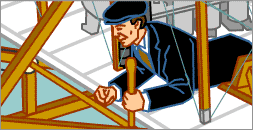|
On December 17, 1903, the Wright brothers flew their "Flyer" four times, with
their longest flight lasting 59 seconds and covering 852 feet.
With these flights, they became the first to successfully pilot a power-driven,
heavier-than-air machine.

Hip cradle
 The Wrights steered their 1903 Flyer with a hip cradle, which the pilot
controlled by sliding his hips from side to side. The cradle was connected to
the plane's wingtips with wires. Moving the cradle caused the wings to twist,
which in turn caused the plane to "roll" (bank). The cradle was also connected
to the rudder, which controlled the plane's "yaw" (rotation around a vertical
axis).
The Wrights steered their 1903 Flyer with a hip cradle, which the pilot
controlled by sliding his hips from side to side. The cradle was connected to
the plane's wingtips with wires. Moving the cradle caused the wings to twist,
which in turn caused the plane to "roll" (bank). The cradle was also connected
to the rudder, which controlled the plane's "yaw" (rotation around a vertical
axis).

Elevator control
 This lever, operated by the pilot's left hand, was connected by a pulley system
to the plane's elevator. With this control the pilot could adjust the tilt of
the elevator and alter the plane's "pitch," or its nose-up/nose-down
orientation relative to level ground.
This lever, operated by the pilot's left hand, was connected by a pulley system
to the plane's elevator. With this control the pilot could adjust the tilt of
the elevator and alter the plane's "pitch," or its nose-up/nose-down
orientation relative to level ground.

Wing warping
To assist in making a turn, the Wrights realized that the plane would have to
bank, or lean, in the direction of the turn (just as a bicyclist needs to lean
when making a turn). To achieve this ability, they developed the idea of
twisting the entire wing, or wing warping. The twisting caused one end of the
wing to have more lift and the other end to have less lift.
To produce the same effect, modern planes use ailerons, movable surfaces
located near the wingtips.

Elevator
The elevator controlled "pitch," or the plane's nose-up/nose-down orientation
relative to level ground. The Wrights placed the elevator at the front of the
plane because they believed it prevented the plane from falling into a
nose-dive and potentially crashing when the plane stalled. They also found the
forward position of the elevator useful in giving a visual indication of the
plane's attitude, or position relative to level ground.
In a modern plane the elevator is typically located in the tail section.

Rudder
With an earlier glider, banking a turn would sometimes cause the aircraft to
spin out of control. To prevent this, the Wrights added a fixed tail to their
1902 glider and then altered it into a movable rudder in the same year. The
rudder in that altered glider and in the 1903 Flyer was controlled by the hip
cradle. The combined movement of the twisting wings and of the movable rudder
allowed the aircraft to bank and turn.
Just as with the 1903 Flyer, the rudder in a modern plane is located in the
tail section.

Engine
Since there were no internal combustion engines available that fit the
specialized needs of an aircraft, the Wright brothers made one of their own.
With the help of machinist Charlie Taylor they built a four-cylinder,
gasoline-powered engine that delivered 12 horsepower and weighed 170 pounds.
The engine's only control was a fuel valve, which was connected to a stick
within easy reach of the pilot. Once the engine was started and running
smoothly, the valve was used only to stop the engine.

Water Reservoir
A long, narrow water tank was attached to a front strut near the pilot. Water
from the tank flowed into the engine and absorbed heat from the area
surrounding the cylinders, keeping the engine from overheating. Cool water from
the tank flowed into the engine as the water in the engine evaporated.

Gas tank
Located on a front strut, the fuel tank held about one and a half quarts of
gasoline. The fuel, which was fed to the engine by gravity, passed through a
valve located near the engine.
Although the valve controlled the flow of gasoline to the engine, the engine
ran at only one speed. The valve was adjusted before takeoff only to get the
engine running as smoothly as possible.

Propellers
The Wright brothers designed and made their own propellers, aided by the use of
their own wind tunnel (which they also designed and built themselves). The
propellers worked as rotating wings; their spinning motion produced a
horizontal lift, or "thrust," that pushed the plane through the air.
Made of two layers of spruce, the propellers spun in opposite directions to
cancel out the torque forces they produced. Without this canceling effect, the
plane would have tended to rotate in a direction opposite that of the rotating
propellers.

Instruments
The 1903 Flyer had three instruments on board: a stopwatch to time the length
of flights, a "Veedor" engine-revolutions counter to measure engine rpms, and
an anemometer to measure distance.

Bicycle wheel hub
Used for taking off, the hub of a bicycle wheel attached to the skids guided
the plane down a narrow, 60-foot wooden rail. The plane rested on a dolly; the
dolly remained behind when the plane took off.
The aircraft landed on its skids.


|